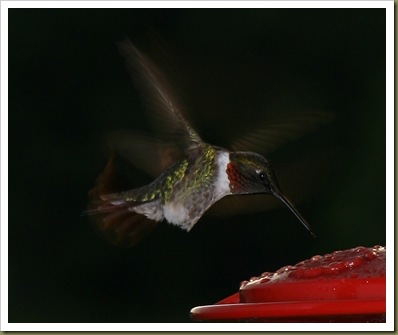In response to my last post titled Hummers Coming in for a Nightcap, I received a comment from a reader that included additional information that I found very informative. Instead of it getting lost in the comments, I decided to make it more visible for others to see and learn.
Thanks Zoe Ann for stopping by and providing this detailed information...
Zoe Ann Hinds said...
Yes, hummingbirds do sleep. They do so at night by entering into a state known as torpor, which is a state similar to hibernation. Hummingbirds must enter this state to ensure that the birds won't actually starve to death before down. Torpor is a type of deep sleep where an animal lowers its hart and metabolic rate. In a state of torpor the hummingbird lowers its metabolic rate by as much as 95%. A torpid hummingbird consumes up to 50 times less energy than when awake. The lowered metabolic rate also causes a cooled body temperature. A hummingbird's night time body temperature is maintained at a level which is barely sufficient to maintain life. This level is known as their set point and it is far below the normal daytime body temperature of 104°F or 40°C known for other birds of similar size.
There are many reasons why the hummingbird must enter into a state of torpor. Hummingbirds are among the smallest of all warm-blooded animals, and they also lack the insulating downy feathers that are typical for many other bird species. Due to their small body size and lack of insulation, hummingbirds rapidly lose body heat to their surroundings. Even sleeping hummingbirds have huge metabolic demands that must be met in order for them to simply survive the night when they cannot forage. By entering into a state of torpor, a hummingbird is able to save enough energy to survive cold nights by lowering their internal thermostat.
It takes approximately 20 minutes for a hummingbird to awaken from a state of torpor. When awakening, the hummingbird's heart and breathing rates increase and they vibrate their wing muscles. The bird's blood supply will be warmed by heat being generated by their vibrating muscles or from shivering. Shivering helps to warm the hummingbird's body temperature by several degrees each minute and the bird awakens with enough energy reserves to see him through to his first feeding of the morning. Hummingbirds reliably awaken from torpor one or two hours before dawn without any known cues from the environment. It appears that the bird's internal circadian clock is responsible for signaling when it is time to awaken from the state of torpor.
Also, here is a link to a blog post I recently wrote about the metabolism of the hummingbird. Hope you like what you find there.
http://hummingbirdsformom.com/hummingbirds/the-amazing-metoblism-of-the-hummingbird/
I have been learning about and developing articles on the subject of hummingbirds for the past year or or so. I operate two websites on the subject of hummingbirds. If you would like much more information about hummingbirds, please click the links below. The sites contain many articles about hummingbirds, video clips about hummingbirds, an informative tips booklet on hummingbirds, and much more.
Click Here To Visit About Hummingbirds
Hummingbirds For Mom
Thanks again Zoe Ann!

1 comment:
We have a wonderful event called the Hummer/Bird Celebration Sept. 11-14 in Rockport and Fulton, TX where we focus on learning about hummingbirds and the fall migration. Please help us get the word out at www.rockporthummingbird.com.
Thanks,
Diane Probst
Post a Comment